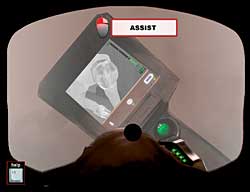Virtual Search and Rescue
A new simulation game tries to show firefighters the advantages of properly using a thermal imaging camera to locate victims.
- By Marc Barrera
- Dec 01, 2006
 Ladder
Company 10. I have a two-story apartment building: Confirmed fire with
multiple entrapment second floor. I need you to gain access through the
second floor window Side B bravo and initiate search.
Ladder
Company 10. I have a two-story apartment building: Confirmed fire with
multiple entrapment second floor. I need you to gain access through the
second floor window Side B bravo and initiate search.
You are Fire Capt. Johns. Your fire chief has just radio-relayed
your orders. You ascend a ladder to the second floor, carrying more
than 50 pounds of equipment with Probational Officer Ed in tow. You
break open a locked window and enter a room that feels like a furnace.
A smoke-filled, gloomy haze blankets the limited vision your respirator
mask allows. How can you hope to locate the victims in this smoke and
heat?
Last May, MSA presented this scenario when it unveiled a video game
simulator titled "Firefighter Challenge: Thermal Response," at the
annual Fire Department Instructors Conference in Indianapolis.
Developed in partnership with Sim Ops Studios, a company whose mission
is to use video game technology to deliver cutting-edge training
simulations for emergency responders, the video game was created to
market MSA's Evolution® 5200 Thermal Imaging Camera (TIC) and
demonstrate its proper use to firefighters.
Firefighters often use TICs, which employ a type of infrared imaging
on a monochromatic display, to see through smoke and locate trapped
victims and fire hotspots. TICs were originally developed for military
use during the Korean War and began to slowly migrate into industrial
applications in the 1990s. Another example of industrial use is in
building construction, where technicians use TICs to identify and
eliminate heat leaks in cooling and heating systems.
The Objective
Similar in maneuverability to the famed computer game Doom,
the MSA simulation is presented in a first-person-shooter perspective.
The player must ascend a two-story ladder, break through the locked
window of a burning apartment, and, before running out of air, find and
rescue victims and locate the source of the fire.
Susie Sapsara, manager of eMarketing at MSA, said since the game's
introduction, it has been played more than 25,000 times by many
firefighters across the country, the majority of whom have responded
positively to the game. "The overwhelming response was how realistic it
is. They couldn't say enough about how real the experience felt to
them. Their least favorite part of the game was that it was over. They
wanted more," she said.
A quick glance at the game's Top 50 Scores list, available online at www.msafire.com,
confirms the range of fire departments whose personnel have played the
game. The list extends as far south as the Red River Army Depot Fire
Department in New Boston, Texas, and up to the Parkland County Fire
Department (PCFD) in Alberta, Canada.
PCFD Lt. Brendan Blazeiko currently holds a top 50 score. Based on
his experience in the field, he said he felt it was a good training
tool for rookie firefighters. "I thought the graphics were very
realistic. I would definitely recommend it to others. It's a good way
to show them what to expect before actually putting them in there," he
said.
Behind the Simulation
Shanna Tellerman, chief executive officer at Sim Ops Studios, said
the game grew from the experience gained, while still part of Carnegie
Mellon University's Technology Center, by collaborating with the New
York Fire Department in the creation of its first instructor-based
prototype simulator, titled Hazmat Hotzone. With the eager
international interest this prototype attracted, a separate company was
formed that began seeking out further uses for this technology, leading
to the collaboration with MSA. "Ultimately, they came to us and said,
'We have this idea we've been wanting to do for a long time about a
game that would show the way our thermal imaging camera works.' We had
a lot of experience working in games and working with firefighters, and
creating these virtual training experiences, so it was kind of a
natural fit," she said.
A newer version of the game has been released that randomly changes
the number of victims and their location, as well as the location of
the fire, each time the game is played. Also, Sapsara said there are
plans to develop similar training simulations for other products.
"We're going to really be looking to leverage that technology, not just
for thermal imaging, but for a lot of our products. We're moving toward
a more 3D-realistic type of environment for training purposes and
things like that," she said.
Sim Ops Studios has also continued to develop other uses for its
technology. Currently, the company has a subscription-based training
service titled "Sim Ops Academy," available at www.simopsstudios.com, which provides different hazmat emergency scenarios and tracks users' progress as they complete them.
This column appeared in the December 2006 issue of Occupational Health & Safety.
This article originally appeared in the December 2006 issue of Occupational Health & Safety.